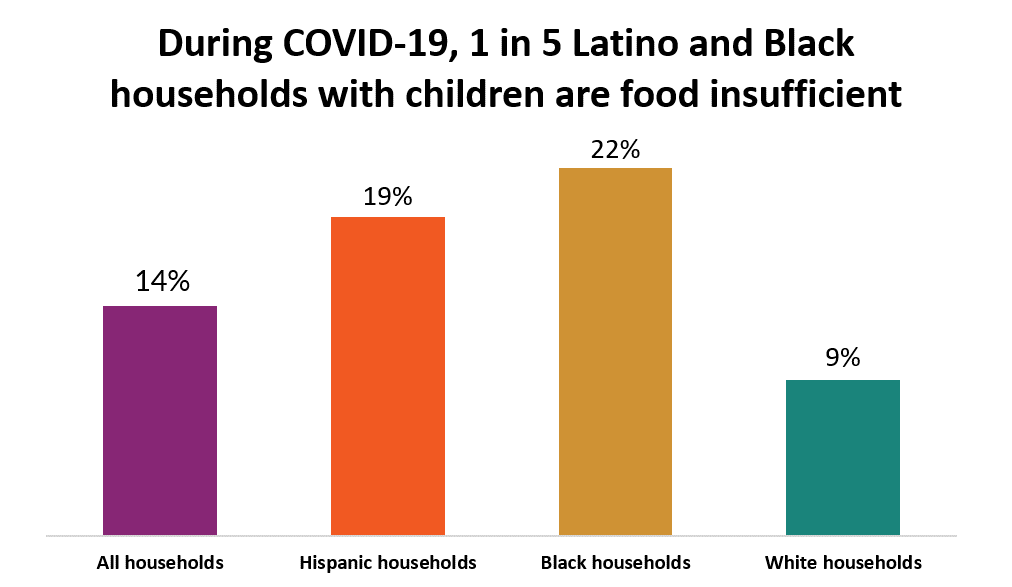Oct 7, 2020
Research Publication
During COVID-19, 1 in 5 Latino and Black Households with Children Are Food Insufficient
Author:
Many Latino and Black households with children are struggling to obtain enough food to feed their families during the COVID-19 pandemic and the ensuing recession. According to data from the Household Pulse Survey, 19 percent of Hispanic households and 22 percent of Black households with children experienced food insufficiency this summer, compared with 9 percent of White households with children. Food insufficiency means that a household sometimes or often did not have enough food to eat in the past week. And racial or ethnic disparities in employment do not fully explain the differential risk in food hardship: Hispanic and Black households with children in which the respondent did not work due to COVID-19 were more likely to experience food insufficiency than comparable White households (Hispanic: 28%; Black: 30%; White: 20%), suggesting that employment status is only part of the picture.

Racial and ethnic disparities in our nation’s workforce, housing, and health care systems may have driven the inequalities in food hardship. About 1 in 7 Hispanic and Black workers were unemployed this summer, compared with 1 in 10 White workers. Hispanic and Black workers have also been more likely to contract COVID-19, less likely to have the option of telework, less likely to receive unemployment insurance, and less likely to be covered by health insurance. In addition, Latino and Black families have had fewer assets such as savings or investments on which to fall back, and have been more likely than White families to experience housing hardships (such as evictions). Hispanic immigrant families face additional barriers to accessing government safety net programs. All of these factors can affect Hispanic and Black families’ ability to meet basic needs.
Children who live in households experiencing food hardship are at higher risk of health, academic, behavioral, and emotional problems than those who do not. Therefore, policies that address food hardship worsened by the pandemic are particularly critical. Several provisions in the Families First Coronavirus Response Act (FFCRA) aimed to help families access food assistance, but ended in September while the economy was still slow in its recovery. When in effect, each provision nevertheless included challenges. For example, benefits increases for the Supplemental Nutrition Assistance Program (SNAP), a program that reduces food hardship, were set to expire when states terminated their emergency status. In addition, although states could request to simplify SNAP procedures to make it easier for families in need to access these benefits, requests to extend administrative flexibility were sometimes denied. The Pandemic Electronic Benefit Transfer (P-EBT) offered debit cards to families with children who were missing out on free and reduced-price school meals due to school closures. However, many states faced challenges getting the P-EBT to families.
Congress recently passed an extension of some of these provisions. To curb the racial disparities that have been widened by the pandemic and protect children from food insufficiency, the federal and state governments should continue or improve upon FFCRA’s emergency provisions, and should consider other policy tools, including income support and housing assistance programs.
Note: We use the terms “Hispanic” and “Latino” interchangeably in the figure and throughout the brief. Our estimates are based on reports of persons in households responding to the U.S. Census Bureau House Pulse Survey and are summarized with the survey weights. A household is considered food insufficient if the respondent reported that anyone in the household sometimes or often did not have enough food to eat in the last seven days. Food insufficiency measured at the household level is comparable to the federal definition of very low food security. We used respondent self-reported data on race and ethnicity to assign households to Hispanic (of any race), non-Hispanic Black, and non-Hispanic White. Children are defined as persons under age 18 living in the respondent’s household. Households in which the respondent did not work for either pay or profit in the last seven days for the following reasons are considered as not having worked due to COVID-19: (1) was sick with coronavirus symptoms; (2) was caring for someone with coronavirus symptoms; (3) was concerned about getting or spreading the coronavirus; (4) employer experienced a reduction in business (including furlough) due to coronavirus pandemic; (5) was laid off due to coronavirus pandemic; (6) place of employment closed temporarily due to the coronavirus pandemic; (7) place of employment went out of business due to the coronavirus pandemic.



